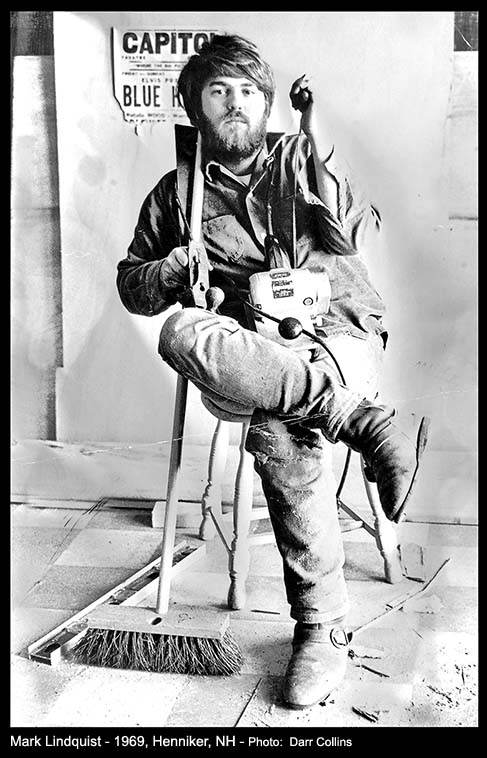| |
MARK LINDQUIST working in Henniker, New
Hampshire 1969

Mark at the Brancusi Museum in Paris, circa 1986 - photo: Kathy Lindquist

Mark Lindquist has been an innovator and leader in the field of
woodturning/sculpture since the late 1960s. Lindquist's thirty-plus years
of contributions to contemporary art have altered the direction of
woodturning and sculpture worldwide.
The Renwick Gallery of the National Museum of American Art, Smithsonian
Institution, honored Lindquist with a 25 year retrospective exhibition in 1995
entitled "Mark Lindquist: Revolutions in Wood."
Ken Trapp, curator-in-charge of the
Renwick Gallery of the Smithsonian American Art Museum, says of
Lindquist's career:
"In the early 1970s, Mark Lindquist’s exploration of Japanese ceramic
traditions and modern sculptural ideals through the medium of woodturning
elevated this traditional craft into an art form expressive of the
cultural and ideological developments of the times. He continues to
transcend the ever-expanding limits of woodturning, adding to the richness
of the discourse within this significant American art movement."
Mark Lindquist's sculpture has evolved out of his art historical studies
and his mastery of, and experimentation with, the craft of woodturning.
Beginning in the late 1960s, he developed many of the techniques and
aesthetic concepts which underlie the current studio woodturning movement,
including the use of flawed materials (especially spalted wood), the
application of modern abrasive technology, and the integration of Japanese
ceramic sensibilities.
Through exhibiting, writing and teaching, Lindquist was instrumental in
bringing about the acceptance of the craft of woodturning as a serious art
form, and inspired and nurtured the followers of this fledgling movement.
Echoes of Mark's innovative turning concepts -- the natural top bowl, the
celebration of the tool-mark on the surface of the bowl, the captive bowl,
the bowl as landscape, and many others -- continue to reverberate
throughout today's turning world. In the late 1970's, having achieved
national acceptance for his work (including acquisition by the
Metropolitan Museum of Art in New York City), Lindquist withdrew from
active participation in the craft world, and began a broader exploration
into contemporary and historical sculptural themes, such as the totem,
Japanese Heian wood sculpture, and the woodblock print.
Lindquist developed a system for coupling the chainsaw to the lathe, and
began producing massive, yet lyrical, sculptures that, while speaking
directly of our machine age, make a timeless statement about the
relationship between man and nature. Using retrofitted obsolete machinery
from the height of the industrial revolution, Lindquist celebrates the
"accidental" rhythms and patterns created by each machine's
idiosyncrasies, just as he celebrates the aesthetic value of the flaws in
his material.
Using his lathe/chainsaw and other innovative technologies as well as
traditional sculpture methods, Lindquist has developed several continuing
series of sculptures, including his "Totemic Series", "Captive Series," "Ichiboku
Series," and polychromed wall relief series.
Lindquist’s works have been exhibited in galleries and museums throughout
the United States and Europe, and have been acquired by the Art Institute
of Chicago, the Mint Museum of Craft and Design in Charlotte, the White
House Collection of American Craft, the Dallas Museum of Art, the Boston
Museum of Fine Arts, the Philadelphia Museum of Art, the High Museum in
Atlanta, the National Museum of American Art of the Smithsonian, the
Detroit Institute of Arts, Bank of America headquarters in Charlotte, and
numerous other public and private collections.
CRITICAL STATEMENTS REGARDING LINDQUIST'S ART
Copyright ©
1997 Mark Lindquist -
http://MarkLindquist.com |
http://lindquiststudios.com | all rights reserved
BIOGRAPHICAL INFO | HOME
| GALLERY
DIRECTORY |
E-MAIL LINDQUIST STUDIOS
SITE DESIGNED BY MARK
LINDQUIST STUDIOS
COPYRIGHT
© 1997 ALL
RIGHTS RESERVED

|
|


